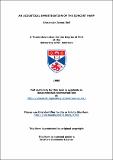Files in this item
An acoustical investigation of the concert harp
Item metadata
| dc.contributor.advisor | Firth, Ian M. | |
| dc.contributor.author | Bell, Alexander J. | |
| dc.coverage.spatial | 451 | en_US |
| dc.date.accessioned | 2012-06-13T14:52:03Z | |
| dc.date.available | 2012-06-13T14:52:03Z | |
| dc.date.issued | 1988 | |
| dc.identifier.uri | https://hdl.handle.net/10023/2768 | |
| dc.description.abstract | This thesis is a report of acoustical research on the concert harp. The harp has an established place in the symphony orchestra and is reacquiring its role as a solo chamber instrument that it had before the development of the modern piano. As far as can be determined, this is the first doctoral thesis on the concert harp and serves as an introduction to the science of the instrument, The experimental methods employed- holographic interferonietry, input admittance measurements, Chiadni glitter pattern methods, sound pressure level measurements- have all been successfully used with work on other musical instruments. Theoretical calculations are used to underpin the experimental results for several of the subjects reported. The experimental results are also compared with the results of similar tests on different musical instruments. Analyses of the violin, guitar and piano are particularly used in discussions. This work is specifically on the "Orchestra" concert harp, manufactured and sold by the Salvi Harp organisation, though reference Is made in Chapter 3 to the "Electra" concert harp, which is also a Salvi harp. The "Orchestra" harp has a similar design to many other concert harps built by different luthiers around the world. This thesis is structured as follows. The first chapter is a review of historical and contemporary research an stringed musical instruments. The next chapter is a detailed description of the Salvi "Orchestra" harps the dimensions of all the inportant features are given, the tensions and materials of the strings are reported and there is also a short description on the playing of the instrument. The next five chapters form the kernal of the research report and deal with the vibrations of the constituent part of the "Orchestra" and finally the completed, strung harp itself. In Chapter 3, the vibrations of the free soundboard are reported in some detail. Analysis is made at a number of stages of the construction of the soundboard itself. The position of the neutral axis on the soundboard is also given. There is also reference to the soundboard of the Salvi "Electra" harp. Chapter 4 deals with the air resonances in the enclosed air volume of the "Orchestra" soundbox. Both a Helmholtzian air mode and higher order air modes are discussed. Theoretical models are used for both forms of air modes, Chapter 5 is a report of the vibrational modes of the "Orchestra" soundbox using both Chladni glitter patterns and holographic interferonietry. The results of Chapter 5 are confirmed and expanded by the work in Chapter 6, where input admittance measurements are made on the soundbox.Chapter 7 investigates the vibrational modes of the soundbox, both in the isolated state and as part of a completed, strung harp. This is followed by a chapter on the directivity of the "Orchestra" harp in which the principal areas of radiation from the harp are reported. The next chapter deals with attempts to relate objective measurements with subjective opinions of six concert harps. The last chapter summarises the principal results of the various analyses reported in this thesis. Suggestions for further research on the harp are made. There are also suggestions for the improvement of the Salvi "Orchestra" harp. There are three appendices at the end of this work. The first deals with the testing of spruce samples intended for the soundboards of the harps. The effect of the veneer is also discussed. The second appendix deals with the production and physical properties of gut harp strings. The third appendix describes the changes to the resonant modes of an isolated soundbox produced by changing the shape of the straining and cover bars of the soundboard. | en_US |
| dc.language.iso | en | en_US |
| dc.publisher | University of St Andrews | |
| dc.rights | Creative Commons Attribution-NonCommercial-NoDerivs 3.0 Unported | |
| dc.rights.uri | http://creativecommons.org/licenses/by-nc-nd/3.0/ | |
| dc.subject.lcc | QC235.B3 | |
| dc.subject.lcsh | Vibration | en_US |
| dc.subject.lcsh | Sound | en_US |
| dc.subject.lcsh | Sound waves | en_US |
| dc.title | An acoustical investigation of the concert harp | en_US |
| dc.type | Thesis | en_US |
| dc.type.qualificationlevel | Doctoral | en_US |
| dc.type.qualificationname | PhD Doctor of Philosophy | en_US |
| dc.publisher.institution | The University of St Andrews | en_US |
This item appears in the following Collection(s)
Except where otherwise noted within the work, this item's licence for re-use is described as Creative Commons Attribution-NonCommercial-NoDerivs 3.0 Unported
Items in the St Andrews Research Repository are protected by copyright, with all rights reserved, unless otherwise indicated.


